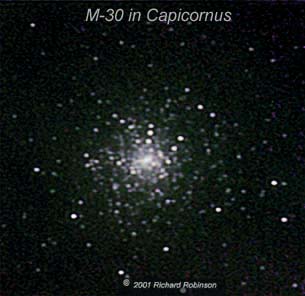|
|
|
|
M-30
is a small and compact globular. It's smaller and dimmer than M-13,
but still offers a nice view. If you can see Capricornus, you should be
able to see M-30 in binoculars or a scope as small as a 90 mm. However,
you will need a clear southern horizon and dark skies if you live in the
northern hemisphere. The bright star to the right of M-30 in the
star chart is Zeta Capricorn at magnitude 3.7. This star may be lost
in haze and light pollution if you live in the northern USA, but if you
can see it you should be able to see M-30. The cluster is about 3
degrees from this star and only about 1/4 of a degree to the right of a
magnitude 5 star.
|
|
 |
Size: 10 arcmin Magnitude: 6.9 Magnitude Tip: 12.1 RA: 21h 40m 22s Dec: -23 d 10m 48s |


